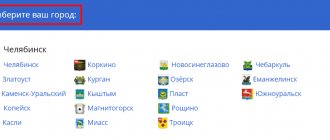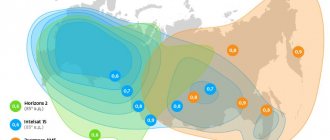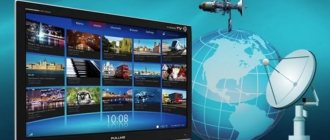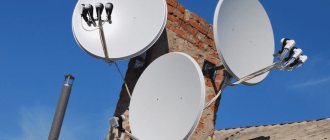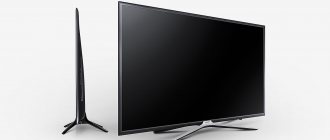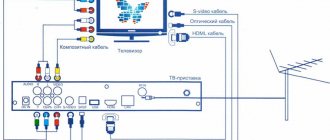With the transition in Russia from analogue to digital broadcasting, many people are wondering whether they need to purchase a set-top box for digital TV, or whether it is better to connect satellite TV. In this text, readers will learn what digital TV is, the features of satellite broadcasting, and find tips on what is best to connect.
What is digital television
Digital television is a modern broadcast format that uses binary signal encoding.
Important! It is worth understanding that digital TV can be transmitted in various ways: by air (that is, from the tower to the antenna), by wire, via the Internet and even via satellite. Therefore, the question “which is better, digital or satellite television” is not entirely correct. Satellite TV also transmits a digital type of signal.
Not all users understand the difference between digital and analog TV, but there is one. Digital television uses analogue broadcasting equipment (TV towers and antennas), with the difference that new, more modern equipment is used to transmit and receive the signal. Thanks to this, several signals (that is, television channels) can be transmitted at once using one broadcasting standard, while the picture and sound are of high quality. With analog technology, the signal was transformed during the transmission process, which worsened the final picture.
It may seem that switching to digital broadcasting from analogue is a waste of money. After all, if the second option only requires a TV and an antenna, then the first will require a special receiver or support for DVB-T2 technology (this is digital broadcast encoding) on the TV. However, the point of switching to digital television is that it increases the number of transmitted channels and allows this to be done in better quality than that of an analog signal. The older generation may remember that 20-25 years ago you could see 1-2 channels on TV, while today digital television offers 20 channels.
At the moment, digital television via an antenna offers you to watch 20 channels for free and listen to 3 radio stations. A plus is the high quality of image and sound, as well as the absence of loss of signal quality as the user moves away from the tower. But there is a minus here - digital television is not available everywhere. The further the subscriber is from the source, the less chance he has of seeing anything. At the same time, digital broadcasting simply does not pick up outside the visibility zone, while analogue broadcasting worsened the picture as it moved away, but still continued to show.
Cable digital TV
It was mentioned above that digital TV can be transmitted via cable. In this case, the user does not need to install an antenna, but needs to extend a coaxial cable into the apartment from the provider's distribution panel. The difference between cable TV and digital via antenna is that the former has more channels available and there are additional services. The downside is that there is a subscription fee. In terms of signal quality there is no difference.
Important! To connect, the buyer will need a receiver or TV support for the DVB-C function; in the latter case, you will need to buy a CAM module.
IPTV
Another type of digital television that is becoming increasingly popular is IPTV or Internet broadcasting. This technology involves the use of the Internet, that is, a twisted pair cable enters the user’s apartment, and then the signal is distributed to the receiver by wire or via Wi - Fi . In terms of ease of use, IPTV demonstrates similar capabilities to cable TV - a large number of channels, additional services. The advantage is the use of one cable for the Internet and television.
However, IPTV is also not without its disadvantages.
- In the event of a line failure, the user is left without Internet and television at the same time.
- When the network is under load, the signal quality may deteriorate. This is especially noticeable in the evenings, when residents in apartment buildings return home from work and actively begin to use the Internet.
Important! To connect broadcasting via the Internet, you need support for this function by your provider, a stable Internet signal, and a special receiver. IPTV requires payment.
Equipment: purchase, configuration and connection
Equipment for digital TV is practically no different from satellite TV. The differences lie in the functioning and complexity of the technical design. The standard kit includes an antenna, a receiver, a coaxial cable, and a connection between the set-top box and the TV. Connection is carried out in the following sequence:
- Gadgets are purchased in accordance with the chosen focus in Tricolor TV salons;
- The location for installing the antenna is selected, the latter must correspond to the direction of the best signal;
- The set-top box is installed, the cable from the receiver is connected to it;
- The equipment is connected to the TV, settings are carried out in accordance with the instructions;
- The television is set, all that remains is to enjoy your favorite programs.
Equipment for satellite TV or digital is available in our stores at :
- Domodedovo, st. Kirova, 7, building 1;
- Vidnoye, Leninsky Komsomol Avenue, 9, building 3, room 302.
All that remains is to give preference to one or another option based on price and the result obtained.
Satellite television
Satellite television is also a type of digital broadcasting. However, it has an excellent operating principle. The signal in this case is distributed from satellites in space. They are located in such a way as to provide high-quality coverage to a certain territory, for example, Russia. The advantage of satellite broadcasting is a larger number of channels, independence from weather conditions and user location . And the last point is the most important when choosing, since all other types are not available to the entire population of the country.
The disadvantage of digital satellite television is the need to purchase complex and expensive equipment. In addition to the receiver or conditional access module, you need a satellite dish that receives the signal. It has complex installation and certain installation conditions. Therefore, connecting satellite TV to an apartment is more difficult than any other option, and usually specialists are called in for this purpose, which entails financial costs. Satellite TV is the most expensive type of digital television. You need to spend money on equipment, installation, and then pay for subscriptions.
Transition to digital broadcasting and abandonment of analogue television in Russia
From February 2021
In Russia, a phased shutdown of analogue television will begin.
The schedule for a complete transition to digital TV is designed for six months
.
The plan includes three stages. Some Russian regions will lose analogue channels on February 11
,
and others on April 15
.
In Novosibirsk and a number of other regions, analogue TV will be turned off on June 3
.
During this time, the authorities plan to inform the population on how to start watching free digital channels in high quality. Those whose TVs do not have a built-in DVB-T/DVB-T2
will need to purchase a set-top box that will receive and decode the digital signal.
(the so-called multiplex)
without purchasing a new TV receiver :
Russia 1, Channel One, Russia 24, OTR, Match TV, NTV, Channel 5, Culture, Friday, Carousel, TV Center, Home, STS, TNT, Spas, Muz-TV, Ren-TV, Zvezda, Mir.
The multiplex also includes free public radio stations: Radio Russia, Vesti FM, Mayak.
What is better to choose for connection?
The features of the operation of satellite and other types of digital television are discussed above, and a summary table with the advantages and disadvantages of each technology will help you understand which is better to choose.
| TV type | Advantages | Flaws | Conclusion |
| Via antenna | Does not require a subscription fee; to connect you will need an inexpensive DVB-T2 set-top box or the presence of a function on your TV. For reception, a regular home or indoor antenna is used without complex installation. | It doesn’t catch everywhere; the further the user is from the tower, the less chance there is of catching the signal. The signal may be blocked by buildings. Often there is no such thing on the first floors, but for the residents of the upper floors everything is fine. As a rule, this type of hanging is not available to residents of villages, dachas and areas remote from cities. The signal drops when weather conditions worsen. Few channels. When connecting several TVs from one antenna, they will show the same channels. | Suitable for city residents who rarely watch TV or who have enough of the main federal channels. The choice of older people who are unable to bear the additional costs of subscription fees. |
| Cable | A large number of channels, high signal quality, you can do without buying a receiver. There is an option to view different content on different devices. The signal does not depend on weather and other factors. | It is necessary to extend the coaxial cable. There is a subscription fee. This type of broadcasting is available mainly to residents of apartment buildings. | Suitable for those who spend a lot of time in front of the TV and live in an apartment building. Laying out a coaxial cable is sometimes easier than installing an antenna. |
| IPTV | A large number of channels, high signal quality, no additional wiring required. You can watch different channels on different devices. | There is a subscription fee. A receiver is required. Internet speed may drop. The signal is not available in case of a line failure. Access to broadcasting is not available everywhere, even if high-speed Internet is available. | The choice of Internet users with a high-speed connection. Suitable if you don’t want to run extra wires into your apartment. |
| Satellite | A large number of channels, high signal quality, which does not depend on the connection location. You can activate the option to view content separately on different equipment from one satellite dish. | High cost of equipment, presence of a subscription fee, rather complicated installation. | To a greater extent, satellite TV is suitable for people who live in areas remote from large cities - villages, dachas, etc., where there is no stable digital television broadcast or the ability to connect cable or Internet television. |
What to choose in the end depends solely on the needs and capabilities of the users. The quality of the content is the same for all types, but the ease of use and connection are different, and the number of channels will be different.
World standards for digital satellite TV
Different countries and regions have different standards. In Russia and European countries this is the DVB (Digital Video Broadcasting) standard.
DVB-S standard (DVB-S2)
DVB-S (in a more modern modification called DVB-S2) is a satellite version of the digital transmission of television signals. The understanding of all ordinary people is that in order to watch satellite channels you definitely need a satellite dish (dish) and a receiver. But it is not so. If the TV supports the DVB-S2 standard, then you will need a so-called “CAM module” - a device for conditional access. It is inserted into the TV, after which the TV is connected to the satellite dish.
The new standard supports all modern high-quality video decks. High connection speed, at which high-resolution image transmission is possible. A more reliable standard in terms of transmitting a broadcast signal from the source to the end user. There is a possibility of direct Internet access.
DVB S2 is compatible with the previous version of the standard - DVB S.
Purpose of development
The new standard coped with the task of eliminating the shortcomings of previous standards - low DVB S speeds and low distortion of the SAT standard. Makes it possible to use digital TV transmission from studio to studio and distribute signals to on-air repeaters.
Used as technical support in forming a network for data transmission or creating IP lines.
The mechanisms built into DVB S2 standard receivers turned out to be incompatible with some older standards. Then 2 new modes were introduced. One can be used for receiving regular services, the second can be used for professional networks.
DVB-S2 has 4 possible modulation schemes. QPSK and PSK are used for broadcasting, and high-speed 16 APSK and 32 APSK schemes are used for professional networks.
Anti-interference is achieved using data interleaving and two-level code overlay for direct correction. Most often it is possible to correct 8-12 errors.
DVB-S2X standard
It is an extended version of the DVB-S2 standard, introducing a number of additional features and functions. Provides higher performance for key applications including DTH platforms, signal distribution, VSAT. The standard provides the ability to use the operating range to meet other needs of the modern electronics market, including the operation of mobile gadgets.
Characterized by higher spectral efficiency signal-to-noise ratios, which is typical for all professional applications. Supports very low C/N, down to -10 dB for mobile applications. (They are used for the operation of ships, airplanes, trains, etc.)
The operation of the DVB-S2X standard is based on the principles of the well-proven version DVB-S2. Uses LDPC forward error correction (FEC) scheme combined with BCH FEC as the outer code.
The specification for the new version has been published in the DVB Blue Book. After this, almost all suppliers of receiving and transmitting equipment announced that they support the new standard.
The new version of the standard was presented almost simultaneously with the advent of the new HEVC video compression system. It is expected that the new receivers will support two technologies to ensure more efficient HD performance.

